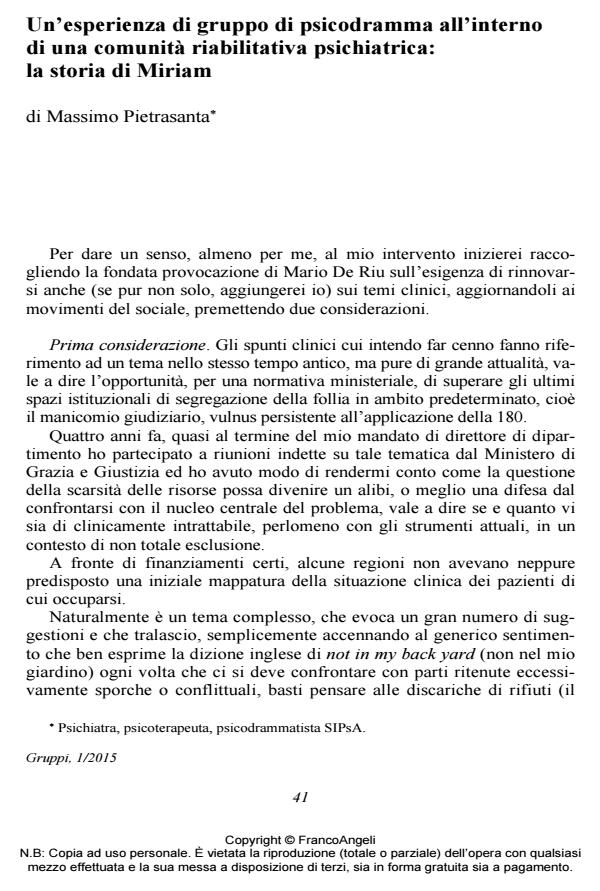Experience psychodrama group within a community psychiatric rehabilitation: the story of Miriam
Journal title GRUPPI
Author/s Massimo Pietrasanta
Publishing Year 2015 Issue 2015/1
Language Italian Pages 11 P. 41-51 File size 49 KB
DOI 10.3280/GRU2015-001004
DOI is like a bar code for intellectual property: to have more infomation
click here
Below, you can see the article first page
If you want to buy this article in PDF format, you can do it, following the instructions to buy download credits

FrancoAngeli is member of Publishers International Linking Association, Inc (PILA), a not-for-profit association which run the CrossRef service enabling links to and from online scholarly content.
The story is set in a psychiatric therapeutic community which is home to 20 patients coming from all over Italy, almost all offenders, alternative measures Judicial Psychiatric Hospital or, in smaller numbers, resigned after serving even for long periods in OPG. The treatment of those convicted as perpetrators, although mentally ill, as included in community facilities, places the therapist in front of ethical questions on the border between illness and crime (s Ethical questions, which sometimes intertwine and overlap issues related to guilt, the penalty, to care both in terms of fantasy that in terms of reality, often with strong impact countertransference. The psychodrama group in the community, without worrying too much about what happens in that area that defines the arena intergruppale Hinshelwood, that is the territory adjacent to the group setting, determines formidable consequences, from the "curiosity" of operators and patients than narrative elements of individual stories. The group, which takes place in weekly sessions of one hour and thirty is characterized by the constant presence, as well as patients, Io Auxiliary fixed, according to the variant of the classic psychodrama applied to groups with seriously ill patients. In our case, the Auxiliary I am a psychologist and two educators, ensuring a function of projective identification more stable in the scenes played, as in psychodrama individual.The group is open to all guests of the 20 communities, but use them 8 patients, some with a constant presence weekly, others with greater discontinuity. Miriam, our protagonist, is a 26 year old girl, the only child of parents of well-off family living in a city in central Italy: it seemed significant retrace its history, for the singular linear evolution, through the sequence of games It represented the most significant in the group, noting that in psychodrama "the game is the fact select: from any model you take the moves is the analytic act par excellence" (Miglietta and Pani). The group has helped Miriam, collecting the speech through the unfolding of the scenes represented, to identify with a mother’s side as she disowned and feared, finding a creative and transformative function that had paralyzed the psychotic break.
Keywords: Psychiatric community, psychodrama, I Auxiliaries, storytelling, theatrical sequences, transformation
Massimo Pietrasanta, Un’esperienza di gruppo di psicodramma all’interno di una comunità riabilitativa psichiatrica: la storia di Miriam in "GRUPPI" 1/2015, pp 41-51, DOI: 10.3280/GRU2015-001004